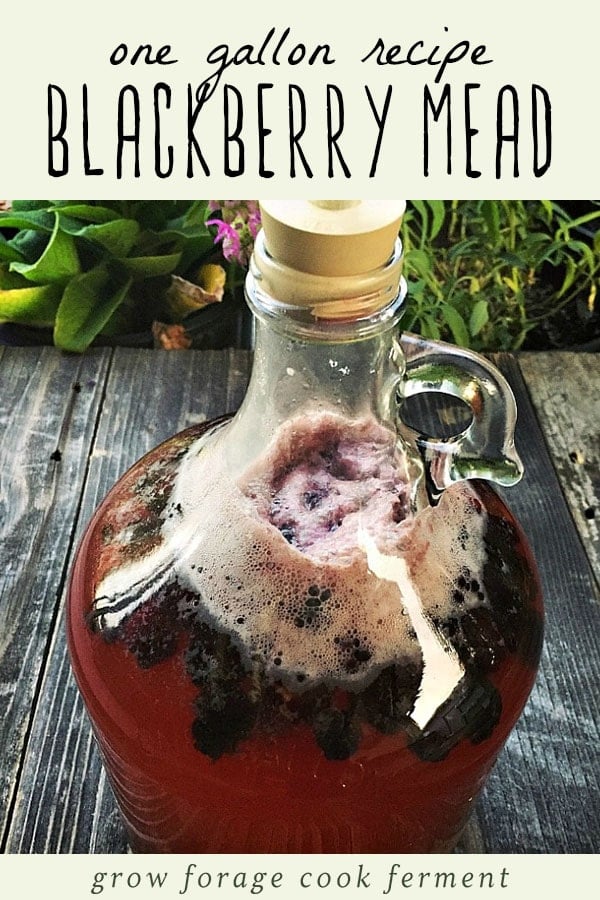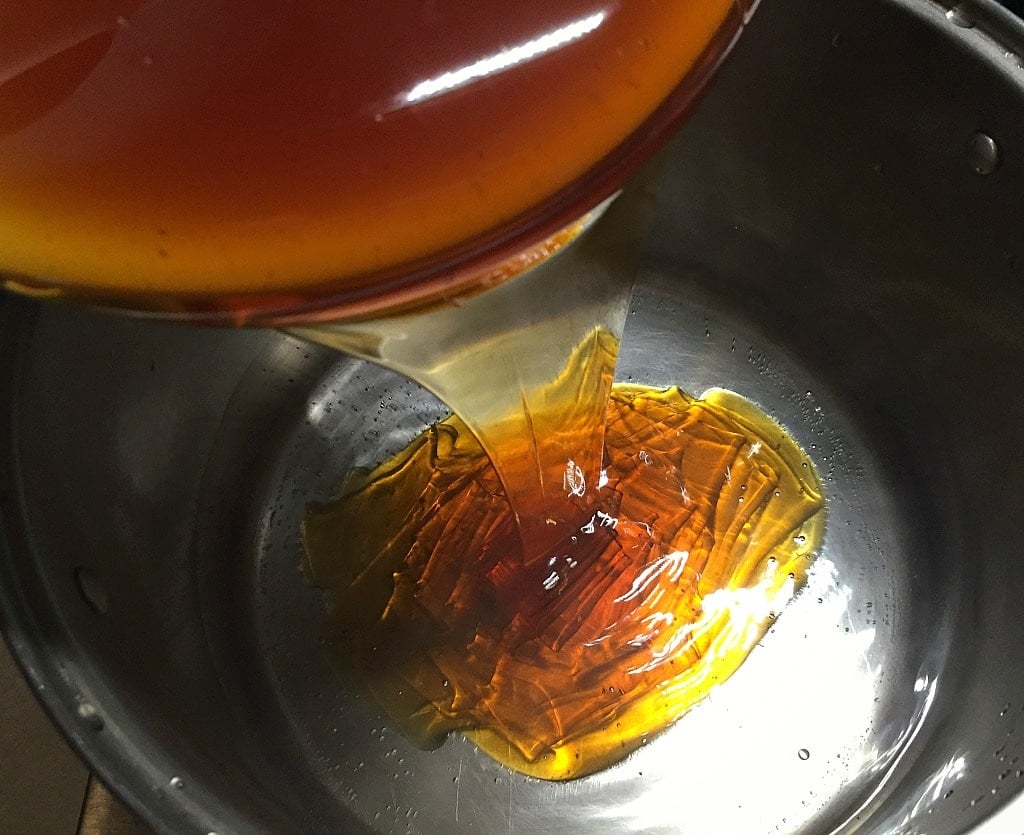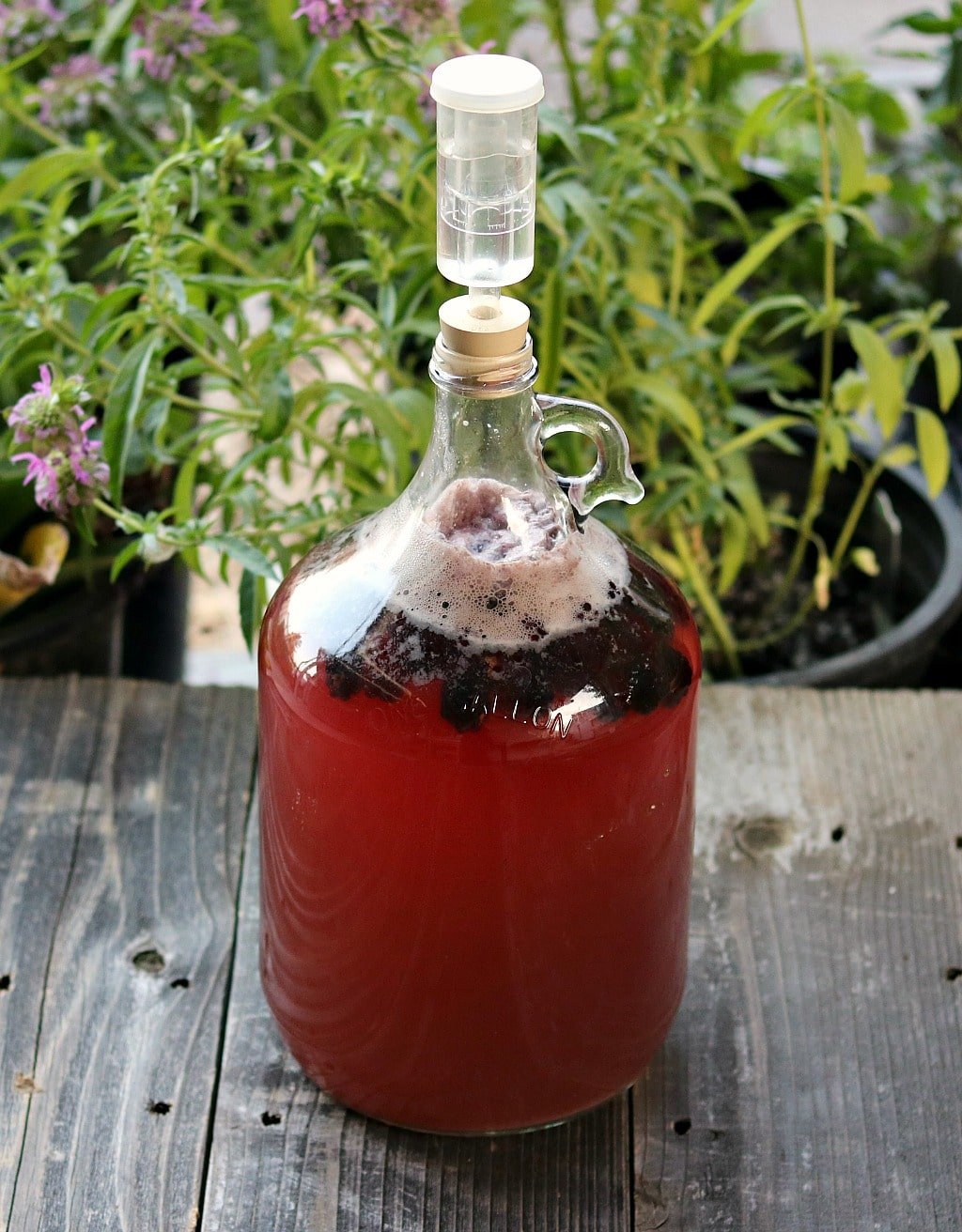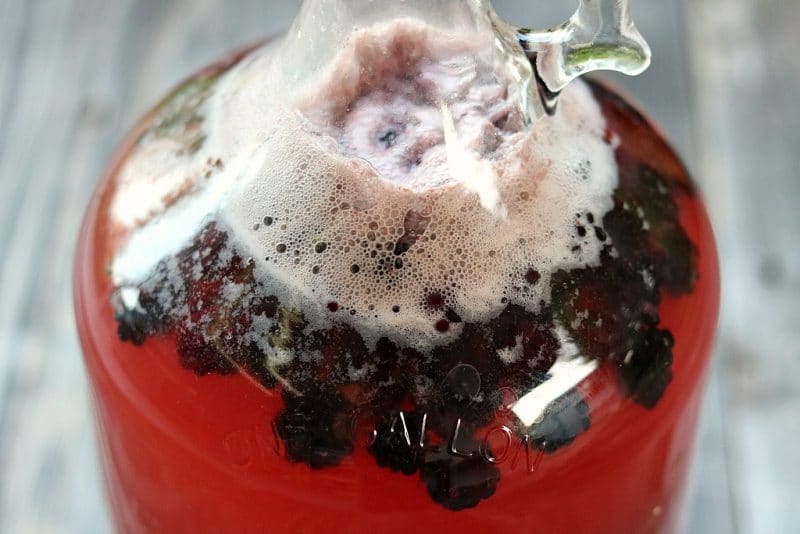Blackberry mead is an easy-to-make, probiotic-rich, sparkling fermented drink. Getting this started in the late summer when blackberries are ripe is a lovely way to have a delicious gallon of mead ready for fall!

Want to save this post for later?
Hot summer days mean one thing to me: blackberries are ripening! It’s usually sometime in August that we start foraging for blackberries, and I always make sure to reserve some for making a gallon (or two or three) of blackberry mead.
Of course, blackberry cobbler and crisp will also be made, and they are delicious, but blackberry mead is really what it’s all about!
Simple Mead Making Ebook
Want to learn more about making mead? I have a Simple Mead Making for Beginners eBook just for you!
It has ingredient and equipment checklists and detailed instructions for brewing and bottling your mead, so be sure to check that out if you’re new to the mead making process!
Harvesting Blackberries for Mead
We recently went out and collected the first ripe blackberries of the season.
Sometimes, blackberry brambles get a bad rap, and I can understand that concern, but you’ll never hear me complaining as I’m gathering bucketloads of tasty and sweet berries!
You only need about one cup of fresh blackberries to make one gallon of mead. I suggest harvesting a bit more so you can eat some along the way!

Blackberry Mead Recipe
This blackberry mead recipe is a variation of my simple one gallon mead recipe.
For more detailed directions and photos of the basic process, head over to that post.
If you don’t have access to fresh blackberries, frozen berries will work just as well.
You will need some special equipment and ingredients before you start making this recipe. To make things easier, I’ve created a page that has links to all of my favorite mead ingredients and equipment here:

I’ve made this recipe for several years now, and it’s always a favorite.
It comes together quickly, which is part of why I love making simple meads and wines, as they are so easy to make!

This blackberry mead is also so pretty while it’s fermenting, it makes it hard to wait!

A bubbly and probiotic-rich mead made with blackberries will be the perfect treat once fall is here.
I will definitely be making a few more batches of this one-gallon recipe before summer is over!
More Mead Recipes
Ready to start brewing your next batch of mead? Here are 15 mead recipes for you to try including:
Blackberry Mead
Equipment
Ingredients
- water non chlorinated or filtered
- 2-3 pounds honey depending on how sweet you want to end product to be.
- 1 cup fresh or frozen blackberries
- 1/2 package champagne yeast
Instructions
- Sanitize everything that will be used in the brewing process.
- Heat about 1/2 gallon of non chlorinated water in the pot on medium heat. Once it’s warm, but not boiling, add the honey and stir it so it all dissolves. Turn off the heat.
- Put the blackberries into the one gallon jug.
- Carefully pour the honey water mixture into the jug using a funnel.
- Top off the jug with cold (preferably filtered) water, leaving at least 2 inches of head space on top. Put the lid on the jug and gently mix everything around a bit.
- Make sure that the temperature of the must is below 90°F, then add 1/2 packet of champagne yeast. Put the lid back on tightly and this time shake the jug for a minute or two to distribute the yeast.
- Put a little water in the airlock to the line, then put the rubber stopper end into the jug. Put the jug in a dark place. It should start bubbling within 12-24 hours.
- After about 6 weeks of fermenting, or once the bubbling has completely stopped, the mead can be bottled and aged.
Notes
- 1 gallon jug with airlock
- Big metal spoon
- Funnel
- A large pot
- Brewing sanitizer (I like One Step brand)




Is 4 lbs of honey too much for a gallon of mead ?
Not if you like it really sweet!
depends on the yeast selection and how well you treat the fermentation. Some fermaid-O and EC-1118 yeast could get 4 lb of honey in a gallon of must quite dry. RC-212 yeast would be cloyingly sweet, assuming that it started at all. For meads I usually aim for about 14% ABV which is about 3 lb of honey in a gallon of must (not added to a gallon of water) (3 lb is also convenient as that’s about a quart and makes some of the calculations easier, like predicting specific gravity when using something other than water for dilution). 71B yeast works great at that ABV and isn’t as violent a fermenter as EC-1118 which can blow a lot of nuances (which you paid for when selecting varietal honey) out the airlock. EC-1118 is a champagne yeast, so is not designed for subtle nuances. Higher ABV brews tend to get less predictable; so if you want more alcohol, drink more good reasonable ABV mead. I’ve pushed beer past 18% just to prove I could, but wouldn’t bother again.
Stumbled across your site just now, after I already have the honey mixture fermenting for 3 weeks. Could I still add the fruit when I rack it off into the secondary and end up with a decent result? I like the idea of the fruit.
Hi Bill. Yes, you can add fruit in secondary. Here is a great resource that walks you through how.
Hi! Quick question before I try this. Do you need to activate the red star champagne yeast before pitching it? I saw the instructions on the yeast indicate to let it sit in warm water.
No, the yeast is added directly to the must.
Hi…I did my first gallon using 2.5 pounds of honey and 2 cups of blackberry instead of one….everything looks fine and it’s chirping away….how will the extra berry’s effect the Mead?
Hi Bob. I don’t think it’ll have any negative effects on the mead.
I am wondering whether it would work to make sparkling mead with this recipe. I’ve read the mead should be a lighter flavoured mead and I am wondering if this recipe would qualify as ‘light’.
I so appreciate all of the recipes and tips you share!
The link for the yeast leads to a sampler pack of five different types. Which one should be used? I’m presuming either the red or the white… or does it even matter?
Hi there. You will need champagne yeast.
Hi I tried to make honeymead I got no dire options of when and how much fermaid k and energizer and nutrient to one gallon thankyou
Hi Larry, my recipes don’t use those items.
Hello! I started a batch a little over two weeks ago and today I noticed that the bubbling had basically stopped, and the liquid has turned fairly clear (still berry colored, but not as murky as it initially was). I was planning to wait 5 weeks, but am wondering if I should bottle sooner. Should I just bottle it? Should I taste it first? If I should taste it, what’s the best approach without contaminating it? Thank you!!
When the bubbles slow down to only a few, it’s time to bottle your mead.
Hello. It may be that your mead has completed fermentation. One way to check – take a sample and use a hydrometer to see what the specific gravity of you mead is. If it’s all the way down to 1.000 (the gravity of water) or below, yes you’re done.
But if your reading is upwards of 1.02 or higher, chances are you fermentation stalled. You can restart it, but it takes a little effort.
I have the same problem it been 6 weeks and I did a gravity reading. It’s at .990. What would you recommend for me to do this now?
purchase and learn how to use a hydrometer; it is your friend… if the specific gravity scale has not moved for a week or two, and is in a reasonable range, it’s done. Rate of bubbling through the airlock is not a good measure of what’s happening. If the specific gravity is not within a reasonable range given your yeast type and lb per gallon of honey, then it’s probably stalled and try readding something like EC-1118 yeast.
Would you ever add herbs ie. Blackberry Basil Mead to these concoctions? Not sure if they would ferment the same as they do when in Kombucha. Thank you!
Thank you so much for this recipe! Mine is now bubbling away, and looks beautiful! After 6 weeks, when I strain out the berries, are there any special steps to bottling, or just pour it in bottles, and call it a day? Thanks again!!
You’re welcome! See my post to learn how to bottle your mead. You definitely want to use an auto siphon and bottling tool rather than just pouring it into bottles, as there will be a lot of sediment.
If you’re wanting to learn even more about the mead making and bottling process, I also have a wonderful eBook, Simple Mead Making for Beginners.
Just bottled my first batch… Looks good, sampled a little and tastes good. Will it clear in the bottle?
Hi Gavin, yes it will get clear in the bottle, any sediment left will sink to the bottom.
Would jarring this like you would with moonshine effect the end product?
It could, depending on how long you left it jarred. Jars have a lot of headspace, which means there is more oxygen coming into contact with the mead. Oxidation could occur if left in the jars too long and produce some funky off flavors.
When do you usually rack the berries out? Or do you usually leave them in the whole time?
I leave them in the whole time until bottling, but you could definitely rack them out after a few weeks if you’d like!
if I want to brew 3 gallons of this, can I simply take the recipe x3?
Do you know if you can use something besides honey, I am a type one diabetic so I have to watch my sugar intake. So it would be great if you know a recipe that might help
Cindy
The honey is converted into alcohol by the yeast. And it’s impossible to make mead without honey.
I wonder if you experimented with erythritol in place of honey what your beverage would be like? It certainly wouldn’t be mead, because you need honey to make mead, but erythritol is a low carb, naturally occurring sugar replacement that could possibly work.
Perhaps make a half recipe as an experiment?
The yeast eats the sugar; something without any sugar will fail.
I like to use a hydrometer when mixing a batch of mead, add more honey or water to obtain a predictable alcohol content
I brewed my first small batch of beer 2 weeks ago and felt Inspired to try making some mead and I Saw this recipe and had to try making it! The one thing I’m unclear on is what’s a good amount Of time to age it in the bottle
Can’t wait to try it, in 40+ days
Do I have to graduate from this method, or can I stay at this beginner level forever? :) I LOVE this method of making mead and am having so much fun with your recipes! Thank you so much for sharing them! — A big fan
I made this with some strawberries, and it’s been two weeks and I’ve noticed that the bubbling has stopped already? Is it done, or so I wait 3 more weeks?
You can actually taste the mead at any time during brewing.
If it has stop foaming the majority of fermentation is over.
It can be because the sugar is already been used up which means the mead won’t be sweet.
In future batches if this happens you can try to add more sugar (honey or smashed fruit) to the must for more fermentation or sweetness.
Thanks for the info and recipe.
Having never done this before……..I think I have an issue.
48 hrs after following the steps…….I have no bubbling going on?
What can I do to salvage the recipe?
Hi Frank, sounds like you need to try adding more yeast. It should definitely be bubbling within 24 hours!
Sounds like the yeast didn’t activate. Depending on what you’re using you might have to put the yeast in warm water at a specific temp and let it rehydrate. Since you already started it try adding s little more after activating it, and also add a few raisins as a nutrient for the yeast.
When it says “bubbling,” it is not like a boil, it’s sometimes barely visible. Your bubbler might burp from time to time, but even that can be hard to catch.
Do you ever rack it or secondary ferment? Have you delt with bottle bombs before?
can i make this recipe without the berries? I want a basic mead in a 5g carboy to then add fruit in secondary.
Hey! They specified above that this was made with their original base mead, so you should be able to find the link up there to make it without the berries!
I made one batch of mead after aging turned to vinegar. Do you need to add anything to stop this. Your recipe how long can you age this , a year ?
sanitizing is your friend; note I didn’t say sterilization. You got vinegar as acetobacters turn alcohol into vinegar; so you got the fermentation right, but you didn’t sanitize well enough. Sanitize everything! I personally like StarSan; you don’t have to rinse it off like you do with bleach or iodophor. I make a 2 1/2 gal batch of starsan and throw everything in there… hands also. Your second best friend is a hydrometer; and learn how to use it as it will let you what’s going on in your brew. Know your yeasts and what they are capable of; note: yeasts can’t read so don’t totally rely on published ABV tolerance… again the hydrometer is your friend. Case in point: 4 lb of honey in a gallon of must (using water) should be able to get quite dry when using something like EC-1118 yeast; the hydrometer will let you know where it’s at.
Hi this is a great resource abs thank you for your advice and input. I to have followed your recipe and all had gone well. It looks a good for colour although it had taken 8 weeks for fermentation to stop. I left it outside in cold weather one night to drop the sediment which it did. I tasted it today and it tastes like vodka!
It certainly warms but there is no taste of blackberry. I’ve tested cornish mead and it is much more fruitful does this cover with ageing or is there another way to make it tasty.
Thank you very much.
The flavor will greatly improve after bottling and aging :)
Add more fruit other recipes I’ve read have lbs not cups
I’m interested in making this but if I use fresh, storebought blackberries, how do I sanitize them? Or do I? Would frozen be better? And where do you get your honey from when you make your mead? Is it commercial or local?
Thanks!
You don’t need to worry about sanitizing the blackberries. Either frozen or fresh will work just fine. I prefer to use local raw honey for my mead, but any honey will work!
Thanks for recommending local honey
If we only knew the importance of buying local honey we would always
You know you are getting real honey when you buy local honey
When you buy off the shelf at big stores you don’t know where it came from or if it is real
It is a great practice to know your local Beekeeper
mmmm! love your recipe! always so easy and clear. is there any reason you only use the half packet of yeast? I accidentally put the whole packet of it. do you think it will be still alright?
It will be fine. The only reason I use half a packet is because it doesn’t need a whole packet to get going and I don’t like to waste it :)
I am following your mead recipe and this weekend will be bottling up my first gallon. Last weekend I looked at it and it wasn’t bubbly but i wasn’t too concerned since I don’t know what it supposed to look like at this point. What i did find is dead gnats (fruit flies) in the air lock. Its been a bad summer around here for them, everyone is complaining but I didn’t think about the fact that I have basically made a trap for them either. My husband said, no worried, they cant get into the wine. Should I be concerned? Have a been patiently waiting for nothing? Thanks in advance for any wisdom you may give
Your husband is right, no need to worry about it!
This sounds pretty tasty. I have a batch of traditional mead that’s bottled and aging now. I’m gonna try to hold out until Christmas before I uncork the first bottle. My mother-in-law has wild blackberries on her property. I was thinking about mashing the blackberries up and using my fermenting bucket for the primary ferment then transferring to.my 3 gallon carboy for secondary, then racking and racking again before bottling. Have you used this method before?
Yes, that method works great!
Instead of an airlock, a large balloon can be placed over the opening of the jug. The gas from fermentation fills up the balloon but it won’t pop. The gas gradually escapes thorough the pores of the balloon, but will not allow air back in.
With as cheap as airlocks are, why wouldn’t you just go with an air lock? I wouldn’t fully trust the balloon method although I have seen people use it. I have 3 airlock and doubt I paid much more than $5 for all.of them.
When my dad brews beer, he takes a hose that fits the hole in the airlock and runs it down to a glass with water in it to help vent off the gasses more efficiently. Once the fermentation slows a bit, he puts an airlock on. This method helps with large amounts of foam.
Correction: He fits a hose in the rubber stopper not the airlock.
I use the balloon method more because I’m used to it because I make my own Jenkem. Balloons are definitely the preferred method for that.
This sounds wonderful! Will adding more berries make fruitier mead. One cup berries to a whole gallon doesn’t seem like a lot. Also, will crushing the berries yield more flavor? Thank you so much!
If you want to add more berries, I would use a fermenting bucket rather than a narrow necked jug, otherwise there may be too much in the jug and the airway could get blocked up. Or, you can crush and strain the berries first :)
If you were to put 1-2 pounds of berries in the bottle but crush and strain them, would it be ok to skip the fermenting bucket step? Also, with crushing and straining, would you put the crushed berries in the bottle or just the juice? Thanks!
Hi, I have a gallon of mead that has been in its first fermentation for 4 weeks now. The bubbles have stopped. Do I use your cider bottling method for the mead? If so, once bottled how long should I let it sit before drinking?
Yes, my method for bottling cider is the same for bottling mead. I usually try and let it sit for at least several weeks, but it does get better with time, so the longer you can wait the better!